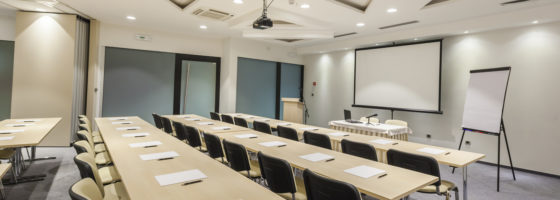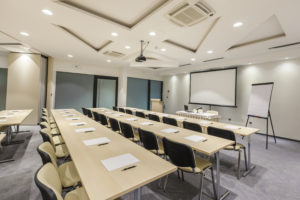What You Need to Know Now About Acoustic Technology in the Acoustic Design of Classrooms
Ben Bausher | April 24, 2017

Technology has profoundly affected many aspects of our lives. But when it comes to acoustic technology design in classrooms, the tail is often wagging the dog. The acoustic design of classrooms can actually influence the technology used in the space. Poor decisions made during the design process have spurred innovations in technology that address the acoustic problems and stimulate new ways of learning.
Today, technology is transforming the classroom into a multimedia experience. Microphone-equipped teachers are amplified through ceiling-mounted speakers. And large screens create a compelling, immersive learning environment.

Modern lecture room
Today’s architects need to consider the technology that is already in the classroom. Interactive smartboards can be found in many classrooms — allowing instructors to add annotations to projected material then distribute the notes electronically to the students. In some schools, students are issued tablet computers that allow them to collaborate with one another and share what they learn on the big screen.
Many of these new technology trends started at the college level before filtering down to K-12. Equipment is typically more advanced in higher education settings because their budgets are more accommodating. College campuses are also the breeding ground for new teaching techniques. For example, some colleges are experimenting with variations on the flipped classroom, with labs and homework being completed in class while lectures can be viewed remotely at a student’s convenience.
Over the last five years, the traditional teaching model has begun to change. Less and less often do students sit in rows facing a teacher at the front of the room who writes on a board and delivers lectures. Increasingly, the in-class teacher is a facilitator rather than a lecturer.
These new learning practices are made possible in part by what’s known as “lecture capture” technology, which records the teacher and any visuals he or she is using. The data is stored on the school server, where it can be downloaded by the students anywhere they have an internet connection.
Lecture capture technology has been around since 1970, when the University of Geneva began taping lectures. Health and medicine programs use the technology frequently and it’s popular with students, who like the flexibility it provides. The systems are a blend of hardware — usually a camera, a microphone, and an easy-to-use software platform.
These systems come with their own set of complications, however. Schools have to wrestle with concerns like how and where the data will be stored and sticky intellectual property rights issues. Additionally, schools need to plan for how to pay for these systems. There are more expensive hardware solutions that have a high up-front equipment cost but don’t have any recurring licensing fees. The other side of this is to have a low-cost piece of lecture capture hardware, and then the school pays a yearly licensing fee for a certain number of units and to unlock various other features.
The latest lecture capture systems allow students to tag, annotate, mark-up and share content. They also help students who miss classes to get back up to speed quickly. In the coming years, we expect more and more school systems will invest in these platforms.
The other big trend effecting the design of acoustic technology in classrooms is wireless. Architects need to consider how hundreds of devices across scores of classroom work together without creating serious performance issues.
Technology can be used to correct acoustic design problems in classrooms, and it’s being tapped to change the way curriculums are taught. Ideally, acoustics and technology should work hand-in-hand to ensure that children can clearly hear their instructors and share what they’re learning with their peers and teachers.

Comments